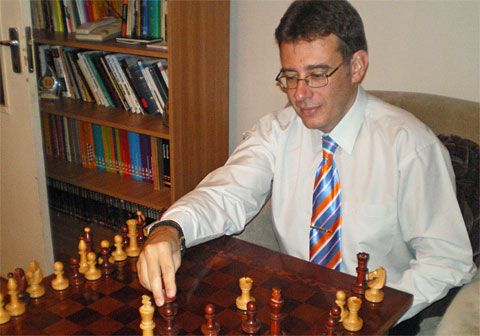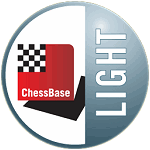
World Championship 2007 Mexico
The World Championship 2007 will take place from September 12 to 30 in the
Sheraton Centro Histórico Hotel in Mexico City. Eight players are qualified
– the tournament will be a double round robin. The prize fund is US $1.3
million.
Commentary by GM Mihail Marin

GM Mihail Marin in his analysis kitchen at home in Romaina
The following express commentary was provided by Romanian Mihail Marin,
who is the author of a number of very popular ChessBase training CDs and articles
for ChessBase Magazine. GM Marin will study the games of the World Championship
tournament in much greater detail and provide the full results of his analysis
in the next issue of ChessBase
Magazine.
Round eleven commentary by GM Mihail Marin
Grischuk-Kramnik ended in a draw very quickly. Gelfand-Svidler lasted longer
and featured an interesting opening fight, but the draw agreement came in a
moment when there was a lot of play left still. Playing with white against Aronian,
Leko managed to obtain an advantage with energetic opening play, but later hesitated
for just one move, allowing the position to become more or less equal. This
evaluation did not change until the final draw agreement.
Anand obtained nice domination on light squares, but Morozevich' kingside counterplay
seemed to keep the balance even. Soon, the radical activation of Anand's knight
turned things to his favour. At some point, Anand could have repeated moves,
which would have suited his favourable tournament position. He bravely decided
to play on, although the position remained irrational. Caissa smiles on the
courageous, and Anand managed to increase his advance over Gelfand by another
half point.
Grischuk,A (2726) - Kramnik,V (2769) [C43]
WCh Mexico City MEX (11), 25.09.2007 [Mihail Marin]
1.e4 e5 2.Nf3 Nf6 3.d4 Nxe4 4.Bd3 d5 5.Nxe5 Nd7 6.Nc3 Nxc3 7.bxc3 Nxe5
8.dxe5 Be7 9.Qh5 Be6 10.Rb1 Qd7 11.Bg5 c6 12.0-0 Bxg5 13.Qxg5
Nothing really breathtaking, with the exception of the speed with which all
these moves were played. 1/2-1/2. [Click
to replay]
Anand,V (2792) - Morozevich,A (2758) [B90]
WCh Mexico City MEX (11), 25.09.2007 [Mihail Marin]
1.e4 c5. For some reasons, Morozevich refrains from his trademark French
Defence again. 2.Nf3 d6 3.d4 cxd4 4.Nxd4 Nf6 5.Nc3 a6 6.f3 e5 7.Nb3 Be6 8.Be3
Nbd7. Sicilians with opposite castling do not necessarily feature sharp
attacks, where everything is decided by the speed of action. In the Najdorf
systems where Black plays ...e5, the relative weakness of the d5-square becomes
one of the main themes. Play can take a strategic course and the kings' position
may become a auxiliary factor, determining players to adjust their plans in
accordance to small tactical details. 9.g4 Nb6 10.g5 Nh5
After the early advance of White's g-pawn, White has increased his control over
the d5-square, but Black has got his share, too: the f4-square.
11.Qd2 Rc8
12.0-0-0 Be7 13.Rg1 0-0 14.Kb1 Qc7 15.Qf2. White forces one more defender
of the d5-square to abandon his position.
15...Nc4 16.Bxc4 Bxc4 17.Nd5 Bxd5
18.Rxd5. White has fulfilled the first part of his plan. The d5-square is
all his, and his bishop is more active than Black's. However, in order to achieve
full strategic success, he needs to transfer the knight to d5 and this is by no
means easy. Moreover, his kingside weaknesses offer Black excellent targets for
counterplay.
18...f5 19.gxf6 Rxf6. One of those small tactical nuances
I was speaking about prevents Black from winning a pawn with 19...Nxf6 20.Rd3
Nxe4? because of 21.Qg2!
20.Qe2 Nf4 21.Bxf4 Rxf4. We can see that, for
practical reasons, the black bishop cannot be considered "bad". We are far from
the endgame still and the presence on board of all major pieces requires concrete
evaluation. The bishop is very useful in the middlegame because it neutralizes
White's pressure along the d-file, while the similar weakness of the f3-pawn is
more difficult to defend.
22.Rd3 Qd7 23.Nc1 Rcf8
24.a3! This is not just a prophylactic move, ensuring White against back
rank problems. The main strategic purpose is to clear the a2-square in view of
the knight's transfer tod5.
24...Kh8. But this might be just a loss of
time.
25.Na2 Qh3 26.Rg3 Qh5 27.Qg2 Rh4 28.h3. White has managed to neutralize
Black's kingisde pressure in satisfactory way. Soon, the knight will become one
of the main actors.
28...Qh6 29.Rb3 b5. We can notice here the meaning
of White's advantage of space. Black's pieces do not have easy access from one
wing to another. Therefore, such a simple attacking move like Rb3 will cause the
chronic weakness of the queenside. The alternate way of defending the pawn would
be 29...Rb8 but after 30.Nb4 there is no way to defend the rook in order to parry
the threats Nxa6 and Nc6. The rook would have to move again, but after, say, 30...Re8
31.Nd5 b5 White has achieved his aim with considerable gain of time.
30.Nb4
Rh5 31.Qf1 Rh4. Threatening ...Rxe4.
32.Qg2 Rh5
An important moment in modern chess history. Anand's most dangerous trailers,
Kramnik and Gelfand, had finished their games hours earlier and a draw would have
maintained his comfortable lead in the tournament. The ambitious decision to play
on will lead to a slightly irrational position, without any safety net for White.
Therefore, Anand deserves the highest praise for the way he chose to climb up
to the highest peak of the chess pyramide. This is the kind of World Champion
the public needs.
33.Nxa6 Bh4 34.Rg4 Bf6 35.Qe2 Rxh3 36.Rxb5 Bd8 37.Rb8 Qf6
38.Nb4 Rxf3 39.Nd5 Qf7 40.Qa6. Each side has created two connected passed
pawns. The fact that they will have to be advanced makes the situation very sharp,
because the kings will remain vulnerable. On general ground, White should be better,
because of is dominating knight, but concretely the position remains unclear.
40...h5 41.Rg2
41...h4? The speed is an important factor in this kind of situations,
but two central pawns are too high a price to pay for just one tempo. 41...Qe6
was necessary.
42.Qxd6 Be7 43.Qxe5. The essential thing now is that White
has a central passed pawn as well, meaning that he does not need to weaken his
king's position yet! The game is practically decided.
43...Rxb8 44.Qxb8+ Kh7
45.Qc7 Bf8 46.Qxf7 Rxf7 47.Rg4 Rf1+ 48.Ka2 Rh1 49.e5
49...Bc5?! Just losing time. 49...h3 would have been more stubborn. WHite
would win the bishop by advancing his e-pawn, but Black's passed pawns would have
maintained some incertitude still.
50.e6 Kh6 51.Rc4! The start of a well
calculated variation. It appears that the bishop has no stability at all.
51...h3.
After 51...Bf8 52.Rc8 Rf1 53.e7 Bxe7 54.Rh8+ Kg5 55.Nxe7 White's pieces keep
the enemy pawns undr control, while the formidable queenside group of pawns is
ready to advance.
52.Rxc5 h2 53.Ne3 Ra1+. A last try. After 53...Rg1 54.e7
h1Q 55.e8Q White has a decisive material advantage and the safer positionof the
king.
54.Kxa1 h1Q+ 55.Ka2 Qe4
56.Re5! A last trick, ensuring the promotion of the e-pawn. 1-0.
[Click to replay]
Gelfand,B (2733) - Svidler,P (2735) [A15]
WCh Mexico City MEX (11), 25.09.2007 [Mihail Marin]
1.Nf3 Nf6 2.c4 g6 3.Nc3 d5. I had started becoming afraid that Svidler
will not play the Grünfeld at all in Mexico. Especially that there was nothing
to complain about his results in the Slav. 4.cxd5. For decades, Gelfand
has been one of the greates (if not just the greatest) specialists of the Rb1
system. However, in Dortmund 2006 Svidler employed a quiet positional line against
him and achieved an excellent position. In Moscow 2006, Gelfand managed to defeat
Svidler with this Anti-Grünfeld move order, only that he delivered the check
one move earlier with 4.Qa4+. 4...Nxd5 5.Qa4+ Bd7 6.Qb3 Nb6 7.d4 Bg7 8.Bf4
Be6 9.Qa3 0-0 10.e4 c6
Actually, this looks very much like a genuine Grünfeld position. White has built
up a formidable centre, but is slightly underdeveloped and his queen is far from
optimally placed.
11.Rd1 Nc4 12.Bxc4 Bxc4. From strategic point of view,
this exchange should favour White, because Black will not have sufficient forces
to sustain the thematic breaks ...c5 or ...e5. However, the fact that the king
cannot castle easily maintains the balance even.
13.Ne5 Ba6 14.Be3 Qd6 15.f4
Qxa3 16.bxa3 f6 17.Nf3 Nd7 18.d5 Nb6 19.dxc6 bxc6 20.Nd4 Rfc8 21.Ne6 Bh6 22.Kf2
Black has a comfortable position. His structure is better, while the e6-knight
is not too stable. 1/2-1/2. [Click
to replay]
Leko,P (2751) - Aronian,L (2750) [E15]
WCh Mexico City MEX (11), 25.09.2007 [Mihail Marin]
1.d4 Nf6 2.c4 e6 3.Nf3 b6 4.g3 Ba6 5.Qa4 Bb7 6.Bg2 c5 7.dxc5 Bxc5 8.0-0
0-0 9.Nc3 Be7 10.Rd1. The 4.Qa4 variation tends to lead to Hedgehog type
of positions. However, Leko has his own views and prefers starting concrete
play from an early stage of the game, giving the position a Catalan character.
10...d6 11.Bf4 a6 12.Qb4 Nc6 13.Qa3 d5 14.Qa4 Qc8 15.cxd5 b5 16.Qc2 Nb4 17.Qd2
Nbxd5 18.Nxd5 Nxd5 19.Rac1 Qe8 20.Nd4
All these moves had been played in one of the games of Leko'smatch against Kramnik.
20...Rc8. Kramnik placed his queen's rook on d8.
21.Bxd5!? The position
is almost symmetrical and White has to play actively if he wants to convert his
slight advance in development into something more concrete.
21...Bxd5 22.Nf5
Rd8 23.Bc7 Rd7 24.e4 exf5 25.exd5 Bd6 26.Re1 Qa8 27.Ba5. White can be happy
with the outcome of the opening. He has a strong passed pawn in the centre, while
the a5-bishop restricts Black's activity, in the same way as in certain Catalan
lines.
27...Rb8 28.a3?! But this overcautious move is hard to understand.
Why not 28.Rc6 , continuing to activate his pieces?
28...b4! A good counterattacking
move. Since Bxb4 would lead to the loss of the d5-pawn, White has to cut his bishop
off the rest of the board. Besides, the b5-square will become available for Black's
king's rook, making the central pawn feel insecure.
29.axb4 Bf8 30.Re5 g6 31.Rc7
Rbd8 32.Rxd7 Rxd7
White will soon lose the d5-pawn and with it, any hope for a concrete advantage.
33.Qe1 Rxd5 34.Re8 Qc6 35.b5 Qd7 36.Kg2 Rxb5 37.Bc3 Qd6 38.Qe3 Rb7 39.Qd4 Qxd4
40.Bxd4 f6 41.Ra8 Kf7 42.Rxa6 Be7 43.Kf3 Rd7 44.Bc3 Bd6 45.Ke2 Be5 46.f4 Bxc3
47.bxc3 g5 48.Ra4 Rb7 49.Rd4 Ke6 50.Rd2 Rb1 51.Ke3 Rc1 52.Kd4 Rf1 53.Re2+ Kd6
54.Ke3 Rc1 55.Kd2 Rf1 56.Ke3 Rc1 1/2-1/2. [Click
to replay]
All results of the round
| Round 11: Tuesday, Sept. 25th 2007, 14:00h |
Boris Gelfand |
½-½ |
Peter Svidler |
Peter Leko |
½-½ |
Levon Aronian |
Alexander Grischuk |
½-½ |
Vladimir Kramnik |
Viswanathan Anand |
1-0 |
Alexander Morozevich |
| |
Current standings

Links





















































